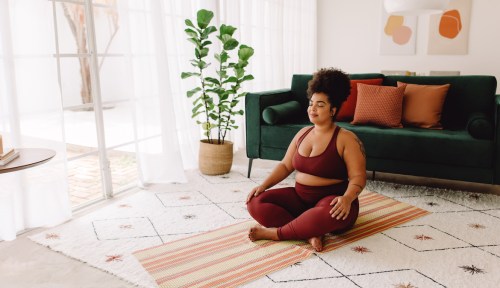‘I’m a Tai Chi and Qigong Expert Known as “The Stressbender,” and Here Are 4 Ways I Release Stress in the Body’
Certain modalities like tai chi and qigong use the body for stress release. Learn a four step sequence you can do yourself.

If you learn just one thing from Shirley Chock, let it be this: Stress is not “all in your head.”
Experts in This Article
In fact, the certified corporate wellness specialist known as “The Stressbender” primarily helps her clients relieve stress by focusing on their physical tension. “When we talk about relieving stress, a lot of people focus on addressing the mental side,” Chock says. “It’s really important to remember, though, that it’s not stress until there’s a buildup of tension in your physical body.”
Whether you’re stressing over an upcoming deadline or an argument with your partner, that mental tension leads to physical reactions that we think of as stress: increased heart rate, high blood pressure, chronic muscular contractions, brain fog, among other responses.
“When you’re stressed out, your brain just doesn’t work as well,” says Chock, who’s a master teacher of both Tai Chi and Qigong. She uses both of those techniques to help clients manage their stress. “Internal martial arts like Tai Chi and Qigong are wonderful techniques for relieving stress because you really have to come into the body to find out where the tension is.”
So how can you relieve stress within your body yourself? This four-step sequence (curated for Well+Good by Chock, using elements from both Tai Chi and Qigong) will help set you up for less-stressed success.
As Chock says, “If you can put your body in an optimal state where you’re in good alignment with good posture and good breathing, you’ll be better able to handle those stresses that are part of everyone’s lives.”
Step 1: Come into your body
Take stock of how your body is feeling physically. “Quiet that analytical part of your brain that wants to overthink everything,” Chock advises. “We can’t relax what we don’t feel is tense.” Listen to your body so you can notice and relax any points of tension.
Not sure where to begin? For many of us, the shoulders hold a lot of physical stress. “Imagine you’re a clothes hanger, hanging in a closet from the crown of your head,” Chock suggests. “Picture gravity as a fluid weight that flows down through your head, neck, shoulders, arms, and fingers. Allow your arms to feel heavy as they hang down by your sides.”
Step 2: Relax your face, then your body
According to Chock, practitioners of Chinese medicine and internal-arts practices often say, “If you can relax your tongue, you can relax your whole face. If you can relax your face, you can relax your whole body.”
Start by gently touching the tongue to the roof of your mouth, right behind your top teeth. Keeping your lips closed, let the tongue spread gently across the roof of your mouth and form a tiny “Buddha smile” with your lips. As you take a moment to get comfortable with this softening of the jaw, you may also notice a corresponding release of tension around your eyes. (Keep up this practice, and you could eventually feel some relief from chronic tension headaches.)
Check in with your overall posture, and repeat Step 1 as needed.
Step 3: Slow down your breathing
“A lot of the tension that we feel can be alleviated by improving, i.e. lengthening, our breathing,” Chock explains. “However, trying effortfully to deepen our breath will add unnatural tension.” To avoid this pitfall, begin by simply noticing where your inhale stops or feels trapped.
Oftentimes, Chock sees clients’ breath stop like this in the upper chest area. If that’s you, try to visualize what the tension feels like. Tight coils? A hard, stuck feeling? Per Chock, creating a clear mental picture of your physical tension will help you release it with equally vivid visual metaphors. Try thinking of washing the tension away with cool water, untangling a ball of string, or anything else that resonates with you.
Step 4: Tune in to your body’s symmetry
“Our bodies are designed to be symmetrical, and they function best when symmetrical,” Chock says. But, she adds, most of us spend our days shifting between uncomfortable, asymmetrical positions.
Chock’s fix? “Learn to notice the stillness, calm, and symmetry in your body.” Maintaining healthy posture and a neutral stance will cut down on the daily bodily micro-stresses caused by poor posture and its close companion: asymmetrical body positions. Put both feet on the floor when sitting, uncross your arms, spread weight evenly between both hips—you’ll feel your body start to feel better.
Sign Up for Our Daily Newsletter
Get all the latest in wellness, trends, food, fitness, beauty, and more delivered right to your inbox.
Got it, you've been added to our email list.








